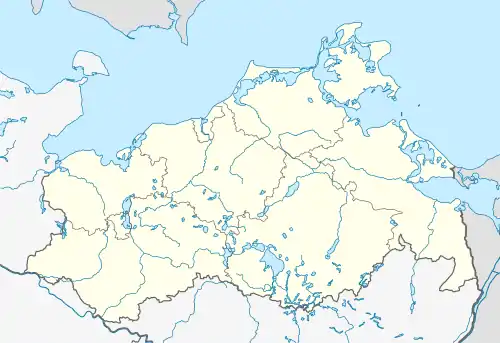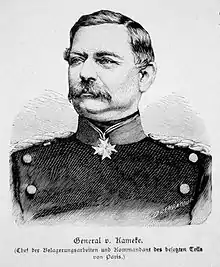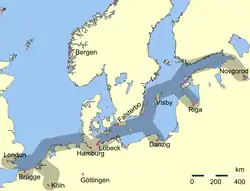Pasewalk
Pasewalk (German: [ˈpaːzəvalk] (![]() listen)) is a town in the Vorpommern-Greifswald district, in the state of Mecklenburg-Vorpommern in Germany. Located on the Uecker river, it is the capital of the former Uecker-Randow district, and the seat of the Uecker-Randow-Tal Amt, of which it is not part.
listen)) is a town in the Vorpommern-Greifswald district, in the state of Mecklenburg-Vorpommern in Germany. Located on the Uecker river, it is the capital of the former Uecker-Randow district, and the seat of the Uecker-Randow-Tal Amt, of which it is not part.
Pasewalk | |
|---|---|
 St. Mary in the center of Pasewalk | |
 Coat of arms | |
Location of Pasewalk within Vorpommern-Greifswald district  | |
 Pasewalk  Pasewalk | |
| Coordinates: 53°30′N 14°00′E | |
| Country | Germany |
| State | Mecklenburg-Vorpommern |
| District | Vorpommern-Greifswald |
| Government | |
| • Mayor | Sandra Nachtweih (Ind.) |
| Area | |
| • Total | 54.99 km2 (21.23 sq mi) |
| Elevation | 15 m (49 ft) |
| Population (2019-12-31)[1] | |
| • Total | 10,047 |
| • Density | 180/km2 (470/sq mi) |
| Time zone | UTC+01:00 (CET) |
| • Summer (DST) | UTC+02:00 (CEST) |
| Postal codes | 17309 |
| Dialling codes | 03973 |
| Vehicle registration | VG, PW |
| Website | pasewalk |
History
Pasewalk became a town during the 12th century and was soon a member of the Hanseatic League. In 1359 it passed to the Duke of Pomerania. Frequently ravaged during the wars which devastated the district, it was plundered several times by Imperial troops during the Thirty Years' War. In 1657 it was burned down by the Poles and in 1713 by the Russians. In the Peace of Westphalia in 1648 it was given to Sweden, but in 1676 it was conquered by Brandenburg. In 1720, in the Peace of Stockholm, it was finally assigned to Brandenburg-Prussia. The town is famous for having been surrendered to the French without a fight during the War of the Fourth Coalition, despite them being way less numerous than the defenders of the city. On the day World War I ended, the future dictator of Germany Adolf Hitler was being treated here after being wounded by a gas attack. During the Battle of Berlin, part of World War II, Pasewalk was captured by troops of the 2nd Belorussian Front of the Red Army on 28 April 1945.
Mayors of Pasewalk
- 1905–1917 Wilhelm Prüter
- 1917–1937 Dr. Willy Peppler (1880-1957)
- 1937–1942 Malsfey
- 1942 Klingbeil
- 1942–? Hans-Heinrich Wentzlaff-Eggebert (born 1894, died ?)
- 1945–? Hermann Bülow
- 1945–1949 Erich Pretzer (1882-1968)
- 1950–1961 Helene Medrow (1902-1976)
- 1961–1974 Eberhard Schmidt (1924-2010)
- around 1982 Börner
- 1986–1990 Bärbel Steinmüller (born 1948)
- 1990–1994 Heinz-Georg Eckleben (born 1945), independent
- 1994–2002 Wilfried Sieber (born 1941), CDU
- 2002–2014 Rainer Dambach (1952-2013), independent
- November 2013-May 2014 Gudrun Baganz, temporary
- since May 2014 Sandra Nachtweih (born 1975), independent
Population over time
|
|
|
Born in Pasewalk

- Wilhelm von Tümpling (1809-1884), Prussian General of the Infantery
- Georg von Kameke (1817-1893), Prussian General of the Infantry and War Ministers
- Erich Paulun (1862-1909), founder of the Tongji Hospital Shanghai, former naval surgeon
- Erich Hamann (born 1944), German footballer and former player of the GDR national football team
- Rainer Knaak (born 1953), German chess player
- Sabine Zimmermann (born 1960), German politician
- Chris Gueffroy (1968-1989), penultimate death victim on the Berlin Wall
Climate
Köppen-Geiger climate classification system classifies its climate as oceanic (Cfb).[12]
| Climate data for Pasewalk | |||||||||||||
|---|---|---|---|---|---|---|---|---|---|---|---|---|---|
| Month | Jan | Feb | Mar | Apr | May | Jun | Jul | Aug | Sep | Oct | Nov | Dec | Year |
| Average high °C (°F) | 1.1 (34.0) |
2.1 (35.8) |
6.9 (44.4) |
12.6 (54.7) |
18 (64) |
21.5 (70.7) |
22.8 (73.0) |
22.6 (72.7) |
18.6 (65.5) |
12.8 (55.0) |
6.9 (44.4) |
3 (37) |
12.4 (54.3) |
| Daily mean °C (°F) | −1.3 (29.7) |
−0.6 (30.9) |
3.4 (38.1) |
8.2 (46.8) |
13 (55) |
16.6 (61.9) |
18.2 (64.8) |
17.8 (64.0) |
14.3 (57.7) |
9.6 (49.3) |
4.5 (40.1) |
0.9 (33.6) |
8.7 (47.7) |
| Average low °C (°F) | −3.6 (25.5) |
−3.3 (26.1) |
0 (32) |
3.8 (38.8) |
8 (46) |
11.7 (53.1) |
13.6 (56.5) |
13.1 (55.6) |
10.1 (50.2) |
6.5 (43.7) |
2.1 (35.8) |
−1.2 (29.8) |
5.1 (41.1) |
| Average precipitation mm (inches) | 38 (1.5) |
29 (1.1) |
33 (1.3) |
38 (1.5) |
51 (2.0) |
60 (2.4) |
63 (2.5) |
57 (2.2) |
48 (1.9) |
41 (1.6) |
45 (1.8) |
44 (1.7) |
547 (21.5) |
| Source: Climate-Data.org (altitude: 16m)[12] | |||||||||||||
External links
 Media related to Pasewalk at Wikimedia Commons
Media related to Pasewalk at Wikimedia Commons
References
- "Statistisches Amt M-V – Bevölkerungsstand der Kreise, Ämter und Gemeinden 2019". Statistisches Amt Mecklenburg-Vorpommern (in German). July 2020.
- Stadt Pasewalk (Hrsg.): Pasewalk. Kulturhistorische und Heimatgeschichtliche Beiträge. Pasewalk 1991, S. 40–49.
- Gustav Kratz: Die Städte der Provinz Pommern. Abriss ihrer Geschichte, zumeist nach Urkunden. Verlag A. Bath, Berlin 1865, S. 282–292.
- Carsten Plötz: Pasewalk 1848–1945. Ein Jahrhundert vorpommerscher Stadtgeschichte, Verlag Dr. Helmut Maaß, Pasewalk 2005, S. 363–369.
- Statistisches Jahrbuch für das Deutsche Reich 1904, S. 10.
- Statistisches Jahrbuch für das Deutsche Reiche 1921/22, S. 9.
- Statistisches Jahrbuch für das Deutsche Reiche 1941/42, S. 19.
- Statistisches Jahrbuch der Deutschen Demokratischen Republik 1955, S. 17.
- Statistisches Jahrbuch der Deutschen Demokratischen Republik 1981, S. 12.
- Statistisches Jahrbuch der Deutschen Demokratischen Republik 1986, S. 12.
- Der Bevölkerungsstand nach Gemeinden und Kreisen in Mecklenburg-Vorpommern, zum 31. Dezember des jeweiligen Jahres. Archived 2015-12-22 at the Wayback Machine SIS-Datenbank des Statistischen Amtes Mecklenburg-Vorpommerns
- "Temperature, Climate graph, Climate table for Pasewalk". Climate-Data.org. Retrieved 2017-09-25.
- "Stadt Pasewalk - Städtepartnerschaft" (in German). Archived from the original on 2014-05-30. Retrieved 2015-03-02.
 This article incorporates text from a publication now in the public domain: Chisholm, Hugh, ed. (1911). "Pasewalk". Encyclopædia Britannica. 20 (11th ed.). Cambridge University Press. p. 883.
This article incorporates text from a publication now in the public domain: Chisholm, Hugh, ed. (1911). "Pasewalk". Encyclopædia Britannica. 20 (11th ed.). Cambridge University Press. p. 883.

